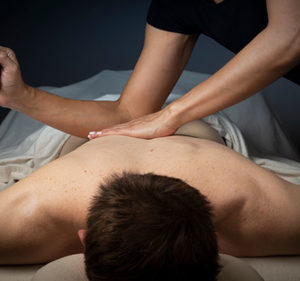Myofascial Release. You have heard of it, but what is it?
We wanted to talk a little bit about myofascial release. A lot of people have heard that term, but don’t really know what it is. A lot of what it’s dealing with is the fascia. The fascia is connective tissue that connects, surrounds, and penetrates muscles, tissue, bone, organs,and nerves. https://youtu.be/SJq3lEeSXKo
 Everything is surrounded and infused with fascia. It is connected from head to toe. It’s a continuous system, so it’s not isolated on a spot here and a spot there. It’s what connects the whole body together. You can have spots that are connected in different places, so something down in the hip or knee might be connected to something up in the shoulder.
Everything is surrounded and infused with fascia. It is connected from head to toe. It’s a continuous system, so it’s not isolated on a spot here and a spot there. It’s what connects the whole body together. You can have spots that are connected in different places, so something down in the hip or knee might be connected to something up in the shoulder.
When we’re working on different things, if we look at the whole body and take that into account, that helps us to get a better picture of what’s going on rather than just trying to say this is a knee problem, we’re just going to focus on the knee.
Some of what we do with the fascia is look at what posture and alignment is because the things that can affect restrictions in the fascia is trauma. Things like car accidents, whiplash, injuries, surgeries, they’ll all cause the fascia to restrict and tighten, but postures will too. For sitting posture, for standing posture. (This blog post is transcribed from a video taken of Aubrey getting Myofascial Release done on her, here she straightens her posture, then goes back to bad posture).
trauma. Things like car accidents, whiplash, injuries, surgeries, they’ll all cause the fascia to restrict and tighten, but postures will too. For sitting posture, for standing posture. (This blog post is transcribed from a video taken of Aubrey getting Myofascial Release done on her, here she straightens her posture, then goes back to bad posture).
That can all create some tightness. You may not be able to see as well on camera, but right here, there’s some tightness right through here in her mid back, her shoulder blades are sticking out just a little bit right there, so there’s some tightness in there. That’s some of what we look at is being able to see what things are out of alignment. Looking at her hips a little bit, this hip is just a little bit higher here.
Those are things that we look at to try and balance things out. That gives us an idea of where to start by just looking at where things are and then we get into it. A lot of it is feel and feeling what’s tight. (Aubrey lays on her stomach).
We were talking about things being straight here, so let’s move this down just a little bit so that’s for you turn back up a little bit. The skin is connected to the fascia, and so there are some techniques we use that are like ASTEM then we put some lubrication on the skin. With myofascial release, we don’t want any lubrication because they use the skin as a handhold to be able to reach the fascia.
You can see, the skin is moving here and it moves a little bit and then it just stops right there, and so that’s where some of this restriction through here is coming, is we get a little bit of movement and then it just doesn’t want to move anymore. Those are things that I’m feeling for where those restrictions are and then work on releasing that.
Sometimes with the fascia, we do some really deep work, like I might go here on her back and put my elbow into her back. When I do that, I don’t just dig in and go as hard as I can, but I feel for where some of that tightness is and then dig into it and wait for it to release.
This helps to break things up and it’s a little bit of the more painful part of it, but this isn’t the major part of the myofascial release. The most part of it is pretty gentle. The fascia tends to respond to really light long stretches. That part that I was just doing helps to break some of those cross links up a little and some of the adhesion a little bit, but the real lengthening of it comes from just doing some simple stretches like this of using the skin for a handhold, putting a little bit of pressure into it.
 Then, the big key and why a lot of people don’t do myofascial release is because it takes at least two minutes, possibly longer, to wait for that to release, and so it takes a little bit of time and patience to work with that. To demonstrate techniques, sometimes there’s not much to see because it just puts a little bit of pressure in and then sit here for a couple minutes. There’s not much to show there. (Aubrey turns the other way to look at neck.)
Then, the big key and why a lot of people don’t do myofascial release is because it takes at least two minutes, possibly longer, to wait for that to release, and so it takes a little bit of time and patience to work with that. To demonstrate techniques, sometimes there’s not much to see because it just puts a little bit of pressure in and then sit here for a couple minutes. There’s not much to show there. (Aubrey turns the other way to look at neck.)
She has a little bit of stiffness in her neck, so I just wanted to look at that. In addition to using the skin, we can use the bone. In this case, I can use the head to be able to hold on to and move to find those spots that are restricted. It can look sometimes just like some typical range of motion exercise, but the main difference is I’m not pushing real hard into that restriction. I feel where the restriction is, just gently go into it, and then wait for it to release. Those are some of the main keys about myofascial release, it is a great treatment technique that helps because a lot of times it gets ignored in the medical system, even in physical therapy.
If you’re having chronic pain problems, lots of different things, neck pain, back pain, fibromyalgia, TMJ, things like that respond really well to myofascial release.
David Butler, PT